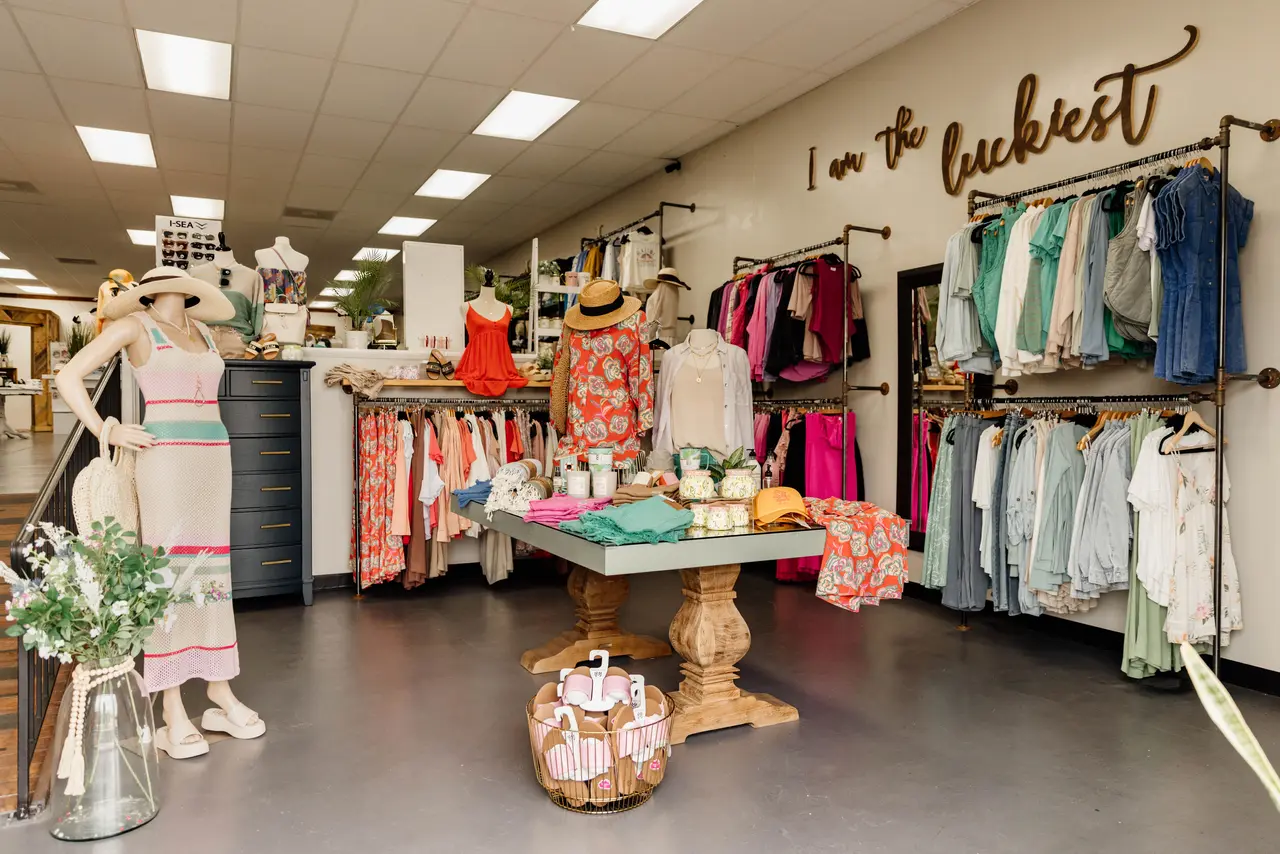Revealing the Secrets Behind Affordable Boutique Fashion
Revealing the Secrets Behind Affordable Boutique Fashion
Blog Article
Lasting Fashion: How Eco-Friendly Clothes Is Shaping the Future of Style
As the apparel industry deals with boosting scrutiny over its ecological influence, the surge of sustainable fashion provides an encouraging choice that straightens design with eco-friendly duty. Utilizing innovative products such as plant-based textiles and recycled fibers, alongside sophisticated approaches like electronic and 3D printing, developers are redefining what it suggests to be classy in the modern-day age. Simultaneously, the growing popularity of upcycling and thrift society is cultivating a change in the direction of a round economic situation. Exactly how does this motion really influence the future trajectory of style, and what obstacles exist ahead in its widespread fostering?
Ingenious Sustainable Products
As the fashion business grapples with its ecological effect, innovative lasting materials have become a critical remedy for lowering ecological impacts. Among one of the most appealing products are those derived from natural, eco-friendly resources, such as organic cotton, hemp, and bamboo. These materials not just decrease dependency on fossil gas but likewise minimize dangerous pesticide use and water consumption. Organic cotton, for example, uses substantially less water than traditional cotton and removes the need for poisonous chemicals, thus protecting dirt health and biodiversity.
In enhancement to plant-based products, innovations in biofabrication have actually resulted in the development of lab-grown textiles. Mycelium natural leather, originated from mushroom origins, offers a biodegradable and functional choice to pet leather. Its production results in substantially reduced carbon discharges and water usage, making it a much more lasting choice for fashion developers looking for to align with eco-friendly practices.
Recycled products are additionally gaining grip, with polyester made from recycled plastic containers representing a considerable innovation. This advancement not only draws away plastic waste from oceans and land fills but also reduces power usage contrasted to producing virgin polyester. Together, these materials highlight the potential for a much more sustainable garment industry, leading the way for ecologically aware layout and manufacturing.
Eco-Conscious Production
Building on the advancements in lasting products, the style industry is additionally re-evaluating its production processes to further minimize environmental influence. Trick techniques include minimizing water intake, reducing carbon discharges, and removing harmful chemicals. By adopting closed-loop systems, manufacturers aim to recycle water and power successfully, dramatically decreasing waste. The combination of sustainable power sources, such as solar and wind power, right into production centers better stops reliance on nonrenewable fuel sources.
An additional essential facet is the reduction of toxic chemicals traditionally made use of in dyeing and finishing fabrics. Eco-conscious makers are moving towards plant-based dyes and waterless dyeing innovations, which not only secure regional environments yet also improve employee security. Developments like digital printing lower material waste and energy usage, using a cleaner alternative to traditional approaches.
With the advancement of blockchain innovation, business can now provide comprehensive understandings right into their supply chains, making sure ecologically pleasant and honest practices at each action. As the demand for eco-conscious products expands, suppliers are forced to innovate, making certain that the future of style is both sustainable and fashionable.
The Increase of Upcycling
Upcycling, a transformative technique in lasting fashion, includes creatively repurposing thrown out materials right into new, top quality items. This ingenious strategy not only lowers waste however also reduces the demand for resources, thereby minimizing the environmental effect of clothing manufacturing. By reconstructing and reimagining existing things, designers and style brands are able to instill originality into their collections while advertising environmental obligation.

Moreover, the upcycling motion has actually equipped independent designers and small services, that often lead in development as a result of their dexterity and creativity. By exploiting on the bountiful schedule of extra site here products, these entities add to a circular economic situation, showing that fashion can be both lasting and elegant. Via upcycling, the sector takes significant strides in the direction of a more responsible and mindful future.
Thrift Culture's Impact
The growing second hand society significantly improves the landscape of sustainable fashion, emphasizing the significance of mindful intake. This social shift urges consumers to accept secondhand apparel, thereby minimizing the need for brand-new garment manufacturing and decreasing ecological influence. Second hand buying not just extends the lifecycle of clothing however likewise lowers the carbon footprint related to production, carrying, and taking care of garments.
A key element of second hand society is its democratization of fashion. By providing a large variety of styles from various eras at budget friendly rates, thrift shops make fashion easily accessible to a broader audience. This access promotes a feeling of individuality and creative thinking, as consumers mix and match special pieces to curate tailored wardrobes without adding to the quick fashion cycle.
Additionally, thrift culture advertises circularity in fashion, aligning with the principles of a circular economic climate. As more customers and designers embrace thrift culture, the style market is forced to adjust, integrating sustainable methods to satisfy the expanding demand for eco-conscious choices.

Future Trends in vogue
Fashion's advancement is progressively shaped by technical advancements and sustainability-driven campaigns. As customers end up being extra ecologically conscious, the market is responding with groundbreaking advancements that redefine the future of design. One famous trend is the increase of digital style, where online garments can be put on in enhanced fact environments, dramatically lowering material waste. This shift not just provides to the digital-savvy consumer however additionally reduces the environmental impact generally linked with garment production.
Additionally, the combination of blockchain modern technology provides brand-new opportunities in openness and traceability, allowing consumers to validate the sustainability qualifications of their clothes. boutique fashion. This makes certain responsibility in supply chains and advertises moral sourcing practices. 3D printing is yet an additional technology that assures to revolutionize manufacturing processes by enabling on-demand manufacturing, thereby minimizing excess inventory and waste
As these modern technologies grow, they are poised to transform the style landscape, combining style with sustainability. The future of style, for that reason, exists in a seamless mix of innovation, technology, and eco-friendly responsibility.
Final Thought
The improvement of the fashion sector with sustainable methods indicates a crucial shift in the direction of environmental responsibility. The assimilation of ingenious products, eco-conscious production methods, and the embracement of upcycling and second hand society emphasizes a commitment to decreasing environmental footprints. As these techniques obtain energy, they redefine the industry's story by focusing on honest and you could look here sustainable choices. This development not just aligns fashion with ecological sustainability however likewise sets a criterion for future trends focused on responsibility and development.
As the fashion sector deals with boosting examination over its ecological effect, the increase of sustainable fashion provides an encouraging choice that straightens style with eco-friendly responsibility.As the fashion industry grapples with its environmental effect, innovative sustainable materials have actually emerged as an essential remedy for lowering try this web-site eco-friendly impacts. Together, these products emphasize the potential for an extra sustainable style industry, leading the way for ecologically aware style and manufacturing.
Structure on the developments in sustainable materials, the fashion sector is additionally re-evaluating its manufacturing processes to better reduce environmental influence. boutique fashion.Upcycling, a transformative technique in lasting style, involves creatively repurposing thrown out materials right into brand-new, top quality items
Report this page